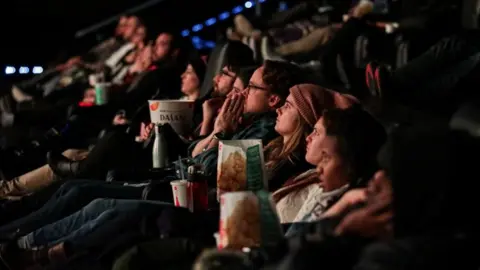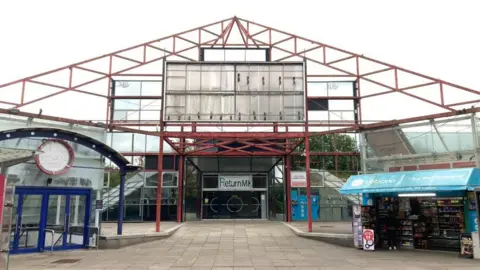 Reuters
ReutersLater this month, two multiplex cinemas within 20 miles of each other will close down.
But while one of them will get a new lease of life with a new operator, one will be demolished to be replaced by a storage site.
What is happening in Northampton and Kettering is symptomatic of cinema closures across the UK, but there are also new sites and operators opening.
So what is the state of play within the cinema industry?
What cinemas have been closing?

Why have cinemas been closing?
 Reuters
ReutersDespite some huge hits, including Inside Out 2 and Deadpool & Wolverine, 2024 was not a good year financially for films, says Charles Gant, the awards/box office editor at Screen International.
“There was a feeling that we would get back to pre-pandemic levels relatively quickly [but] it became apparent it wasn’t an instant recovery,” he says.
“The recovery has completely stalled and that is to do with the release calendar, which was impacted by the Hollywood strikes.”
In 2023, both writers and actors in the United States took industrial action, which halted the production of several major films and delayed their release.
“We haven’t had consistent releases of big tentpole films until we got to November,” says Mr Gant.
Richard Clifford, programmer at the two-screen Northampton Filmhouse, agrees and says 2024 was “a challenging year in general for the industry”.
He says the November releases of Gladiator II, Wicked, and Paddington in Peru “certainly helped every cinema around the world”.
Mr Clifford, who has also worked for Cineworld and Vue, adds that audiences “haven’t seen the wider range of films” with fewer documentaries, British films and foreign films released.
Phil Clapp, chief executive of the UK Cinema Association, says: “Some cinemas which would’ve been economic to run before the pandemic, before recent [financial] challenges, are no longer economic and so they’re being closed in many cases.”
Some of those will be reopened by other operators, he says, “but inevitably it will mean that some communities lose their local cinema, [which] really does have an impact”.
Is smaller the future?

Mr Gant says cinemas face rising costs as many industries do, in particular with energy and staffing.
“They are large buildings and some of them are probably not built in the most energy-efficient manner,” he says.
“Some of the stuff that got built in the 1990s are these of out-of-town sheds.”
But new cinemas are opening and Mr Clapp says operators recognise they need to “offer something more than people would get at home.
“The general trend is to more reclining sofas [and] a more upscale experience, and part of that is a move away from the large auditoriums with hundreds of seats,” he says.
He adds that rather than looking only at capacity, cinemas want to increase occupancy or, “put simply, bums on seats”.
That’s the general direction of travel for many in the UK cinema sector and indeed in European and global cinemas,” he says.
But he adds: “There is an audience out there still for the big-screen experience.”
Mr Clifford says a smaller venue such as Northampton Filmhouse – which has two screens, each with a capacity of about 90 – can have “a different kind of audience that comes on a regular basis”.
“They come here so regularly. They come and see everything we put on,” he says.
Will 2025 be better for cinemas?

Mr Clapp says 2025 looks “something like the normal film slate” for large studio films.
“What still needs to build back is the next tier and more diverse films – the films that appeal to a broader audience than [the] mainstream blockbusters,” he says.
He adds that his members “from the large multiplexes down to the smaller, independent cinemas” are confident about both this year and next year.
Mr Clifford agrees, saying that 2025’s “line-up is stellar compared with [2024]”.
He adds: “There are so many strong films… 2025 is a much more hopeful year for people in my role.”


